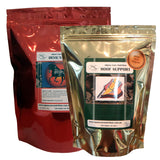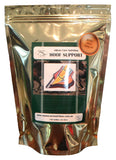Spring grass: separating the facts from the fear
 With the Spring grass starting to grow out there, now would be a good time to get down to the roots of the matter and to try and understand how best to manage grass and grazing for our horses, particularly those with insulin resistance or at high risk of laminitis. Do we need to fear grass or the season? How do species, growth and the environment interact, and what impact can we have on this dynamic relationship?
With the Spring grass starting to grow out there, now would be a good time to get down to the roots of the matter and to try and understand how best to manage grass and grazing for our horses, particularly those with insulin resistance or at high risk of laminitis. Do we need to fear grass or the season? How do species, growth and the environment interact, and what impact can we have on this dynamic relationship?
|
GLOSSARY: NSC - non structural carbohydrates are simple sugars such as glucose, fructose and starch. Structural carbohydrates - occur in the cell wall of the plant, commonly known as plant fibre. Bacterial fermentation in the gut of the horse is required to break these down. WSC - water soluble carbohydrates. Represented as a fraction in hay/grass analysis, it is the sum of the simple sugars and fructans. |
FACT #1: All grasses contain sugar.
Sugar is a product of photosynthesis and without it the plant would die. The process of photosynthesis allows the plant to convert light energy into chemical energy to fuel plants activities. This includes producing fuel (sugars) for growth by taking carbon dioxide from the atmosphere and drawing in water and nutrients from the soil to synthesise carbohydrates. Generally speaking sugar is produced during the day and used during the night to help the plant grow. This mechanism for using sugars for energy and growth is called respiration.
FACT#2: There are 2 broad grass classifications based on photosynthesis.
Plant species are divided into the categories C3 or C4 depending upon the exact chain of molecules produced during photosynthesis. This difference relates to the environmental conditions the plant has adapted to survive in. C3 grasses are cool climate, and grow best in areas where the spring is cool and wet. Very many of our improved pasture species are C3 grasses: they have been selected to thrive in the temperate areas of the world where the majority of our agricultural production takes place, whilst being hardy enough to survive grazing during the colder winter months. Examples of C3 grasses include ryegrass, fescues, cocksfoot and brome. Native species include Wallaby, Spear, Common Wheat Grass and Weeping Grass. Some C3 grasses are so well adapted they can even continue a low level of photosynthesis under a light layer of snow.
C4 grasses by contrast thrive in sub tropical and tropical areas where the summers are hot and wet. They can be efficient in high temperatures that would shut down a C3 grass. Examples include kikuyu, couch, Rhodes and buffel grass, along with a host of natives such as kangaroo, red-leg, tall windmill, Queensland bluegrass and spreading umbrella.
These two broad categories of grass produce different carbohydrates through photosynthesis and their levels of NSC's (non-structural carbohydrates) tend to be different. C4 grasses tend to be lower in NSC as they produce starch rather than fructose, and once their starch stores are full, production stops. C3 grasses produce fructan which is stored in various places all over the plant, and production and storage will continue as long as conditions are conducive to the formation of sugar.
FACT#3: Different parts of the plant have higher levels of NSC depending on its stage of growth.
Plant scientists use the terms 'source' and 'sink' to describe the dynamic relationship of carbohydrate production and distribution within a plant. The SOURCE is where carbohydrates are stored or produced and the SINK is where they are used. In early spring, carbohydrates stored in the seed, crown, stem base or root, are the sources of the carbon and energy needed to form new leaves, which are the sink. When this new leaf becomes large enough to produce more carbohydrate through photosynthesis than is needed for its growth, it becomes a source. 'Sink' areas for excess NSC might be new leaves, root, stem or seed production. During the stem elongation phase, the developing reproductive organs in the stem are the sink. During the seed filling stage, the stem then becomes the source and the seed is the sink.
Although we worry about the sugar in a 'new flush', healthy actively growing grass can be lower in NSC. The first 2-3 leaves of new growth are a 'sink' and have used up NSC reserves to accomplish that growth, and when grass is growing fastest in mid-summer warmth, NSC levels can be at their lowest concentration for the year.
BUT, and this is a HUGE BUT, environmental conditions can have as much, if not more influence on NSC levels than stage of growth at any given time. As stated above, photosynthesis occurs during the day and respiration (the mechanism of using sugars for energy and growth) occurs at night. Of the two processes, respiration (energy usage) is usually affected by environmental factors before photosynthesis (energy production), so while the plant merrily keeps on producing and storing sugars, rates of usage can dramatically decline, resulting in a net increase in the amount of sugar in the plant.
ENVIRONMENTAL FACTORS THAT EFFECT NSC LEVELS:
TEMPERATURE: Night time temperature has a direct affect on respiration and therefore the amount of NSC the plant uses and how much might be left over the next day. Night time temperatures below 5°C will slow respiration, resulting in higher NSC levels. Imagine a typical spell of early spring weather: cold nights and frosty mornings, but bright clear sunny skies during the day. The grass is busily producing energy during the day, but the cold night suppresses the amount used in respiration. Such conditions can double the NSC content of grass.
During our hotter months however, high night time temperatures can cause respiration to become an energy sink in C3 (cool season) grasses; burning up sugars that might otherwise go towards growth or seed production.
TIME OF DAY: Levels of NSC will be lowest from about 3am to 10am, with levels peaking in the afternoon and gradually declining after the sun goes down.
SUNLIGHT: Intensity has a direct effect on carbohydrate synthesis. Cloudy weather or shade reduces NSC levels. On an overcast drizzly day NSC levels may not rise much from morning levels throughout the whole day as the weather conditions directly impact levels of photosynthesis.
STRESS FACTORS: Photosynthesis keeps on making sugar as long as the sun is shining, but if the plant is not getting other elements it needs for healthy growth, the growth slows or stops, whilst sugar keeps on being synthesised and stored. Lack of water/drought can cause stress and increase NSC levels. Nutrient deficiency is another kind of stress: nitrogen and phosphorous deficiency are well documented triggers for NSC increases in grass.
HOW WE CAN MANAGE THE ENVIRONMENTAL FACTORS
We cannot influence the weather, but we can manage our grazing times to take advantage of lower NSC content, for example, in the mornings before 10 am, perhaps longer grazing spells on really dreary days, or restricting grazing to areas of paddocks that are in shade.
We can also actively manage our pastures to try and prevent grass stress. If a pasture is made up primarily of improved grass species, we need to recognise that these species have been selected for their greater productivity, and with this comes a higher requirement of managed input such as irrigation and fertiliser. What though is the management practice of most horse owners? Benign neglect. If grass is perceived as the enemy then we can fall into the trap of discouraging its growth or vigour, but in doing this we can be creating an even greater problem by increasing NSC levels due to plant stress. In a paddock with stressed grass, the amount of NSC per acre may be less (as there is less plant growth), but the amount of NSC per mouthful of grass is higher: the grass is stressed, growth has slowed and all that sugar that is being produced every day is being stored. In a lush healthy paddock, the amount of NSC per acre may be more (as there is a lot more plant matter in that acre), but the amount of NSC per mouthful is less: it is being used by the plant for growth. If we have improved pasture species in our paddocks, then unless we go to the effort of reseeding with lower NSC varieties, we are better off to encourage healthy, unstressed growth and then manage the amount of volume our horses and ponies have access to, rather than turning a blind eye, and causing high NSC varieties to become even higher in sugar because they are under stress conditions.
Unfortunately there is no simple answer to how to safely graze high risks animals in a system that is as dynamic as the interactions of genetic potential, life cycle and environment: factors that change over the course of a day, and from one day to the next. With a better understanding of this complexity however, we can become more dynamic and flexible in our management and grazing practices to promote better health for both our animal and plant charges.
|
RELATED PRODUCTS |
|||
 |
 |
 |
 |
| Laminitis Recovery |
Hoof Support |
Hoof Builder |
Devil's Claw |